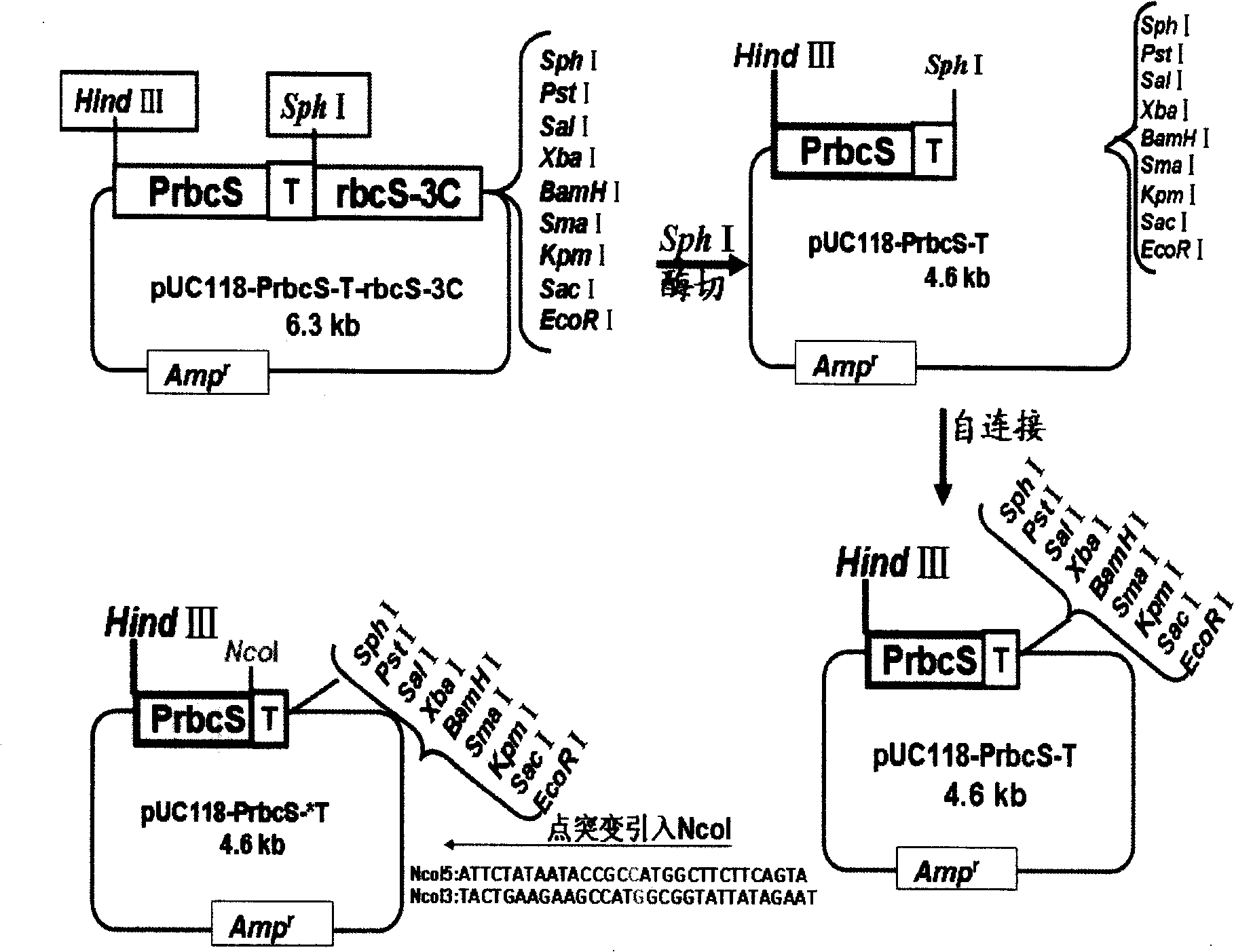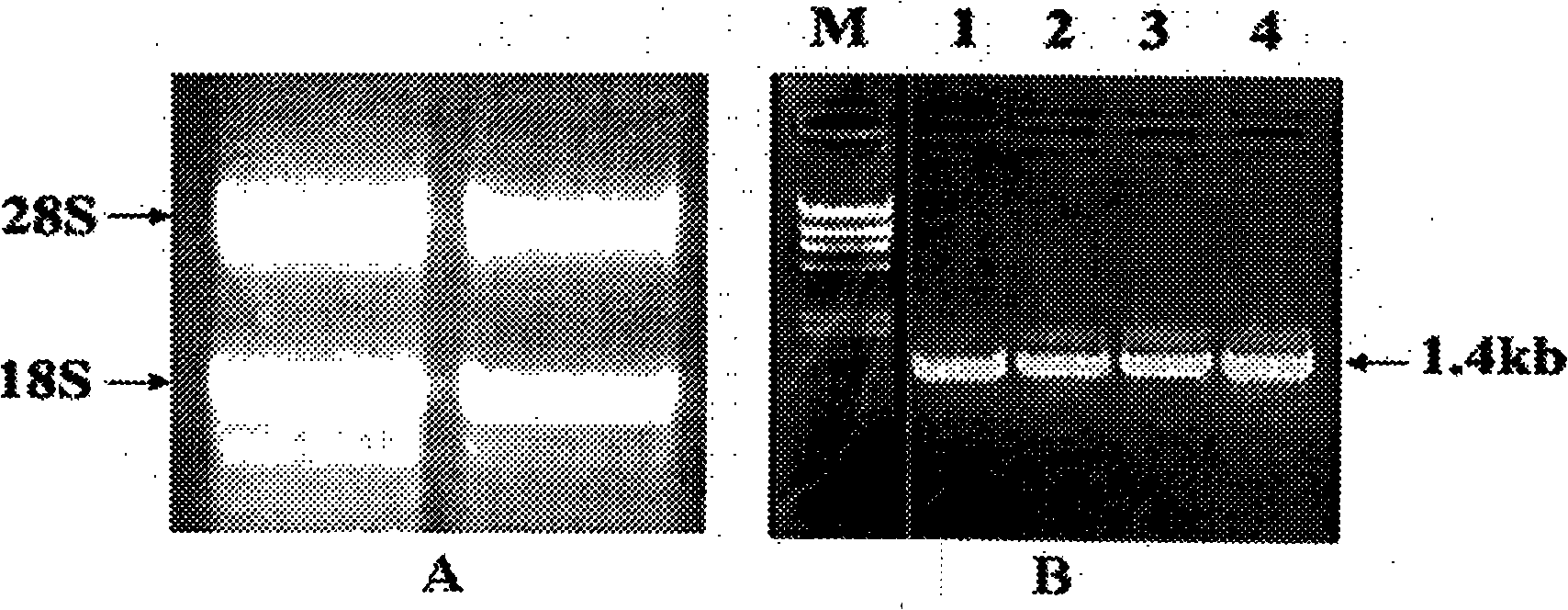Plant expression vector of citric acid synthesis gene and application thereof
A plant expression vector and gene technology, applied in the field of plant genetic engineering, can solve the problems of no tissue specificity, etc., and achieve the effect of improving resistance, improving tolerance, and good root growth
- Summary
- Abstract
- Description
- Claims
- Application Information
AI Technical Summary
Problems solved by technology
Method used
Image
Examples
Embodiment 1
[0057] Embodiment 1, construction of intermediate vector pUC118-PrbcS-T
[0058] Purify (operate according to kit instructions) pUC118-PrbcS-T-rbcS-3C (constructed and provided by Sugita et al., Sugita et al., 1987, MGG, 209: 247-256) with a plasmid extraction kit (Broadtech) , the rbcS-3C in pUC118-PrbcS-T-rbcS-3C was cut out with restriction endonuclease SphI (Fermentas), and the cut vectors pUC118-PrbcS-T and rbcS-3C were separated by agarose gel electrophoresis Fragment, recover the 4.6kb vector pUC118-PrbcS-T, and then use the ligase kit of TaKaRa to ligate (operate according to the kit instructions) the vector DNA fragment without rbcS-3C to generate an intermediate vector pUC118-PrbcS -T( figure 1 ), converting the high efficiency (10 8 ) Escherichia coli competent cells (DH5α, Tiangen Biochemical Technology), spread the transformed Escherichia coli on a plate added with ampicillin (Amp, 100 μg / ml), cultivate overnight at 37°C, and screen Amp-resistant recombinants ...
Embodiment 2
[0059] Example 2. Using point mutation technology to introduce NcoI site into the intermediate vector pUC118-T-PrbcS
[0060] Using the purified plasmid pUC118-Prbcs-T as a template, a pair of complementary primers (NcoI5 and NcoI3, NcoI3, figure 1 ), commissioned TaKaRa to synthesize. Add 25ng of purified plasmid pUC118-PrbcS-T to the point mutation reaction mixture as a template, and at the same time add 125ng of point mutation primers NcoI5 and NcoI3, 1μldNTP (2.5mM), 5μl of 10×KOD reaction buffer and 1μl of KOD polymerase (Toyobo Japan), add double distilled water to make the final reaction volume 50 μl. Heated at 95°C for 30 seconds on a PCR instrument, followed by 15 cycles of reaction at 95°C for 30 seconds, 55°C for 1 minute, 68°C for 10 minutes, and finally extended the reaction at 68°C for 10 minutes to synthesize The child chain of the mutation site. After the reaction was completed, the reaction mixture was cooled on ice for 2 minutes, 1 μl of restriction endon...
Embodiment 3
[0061] Embodiment 3, the construction of plant expression vector pPZP211-PrbcS-cs
[0062] The construction strategy of the plant expression vector pPZP211-PrbcS-cs is as follows: figure 2 As shown, the first choice is to search the full-length gene sequence of tobacco cs from GenBank, and design a pair of specific primers to amplify the first-strand cDNA of tobacco as a template to obtain the full-length cDNA of cs, recover and purify the cs full-length gene fragment, Connect it to pMD18-T vector to obtain pMD-cs. Digest pMD-cs and pUC118-PrbcS-*T with NcoI and XbaI, recover and purify the cs gene fragment and the large vector fragment pUC118-PrbcS, and then connect and obtain the recombinant plasmid pUC118-PrbcS-cs. Digest pUC118-PrbcS-cs and pPZP211 with HindIII and XbaI, recover and purify the small fragment PrbcS-cs and large fragment pPZP211, and then connect to obtain the recombinant vector pPZP211-PrbcS-cs, which contains the promoter PrbcS, followed by cs Gene. Th...
PUM
 Login to View More
Login to View More Abstract
Description
Claims
Application Information
 Login to View More
Login to View More - Generate Ideas
- Intellectual Property
- Life Sciences
- Materials
- Tech Scout
- Unparalleled Data Quality
- Higher Quality Content
- 60% Fewer Hallucinations
Browse by: Latest US Patents, China's latest patents, Technical Efficacy Thesaurus, Application Domain, Technology Topic, Popular Technical Reports.
© 2025 PatSnap. All rights reserved.Legal|Privacy policy|Modern Slavery Act Transparency Statement|Sitemap|About US| Contact US: help@patsnap.com



